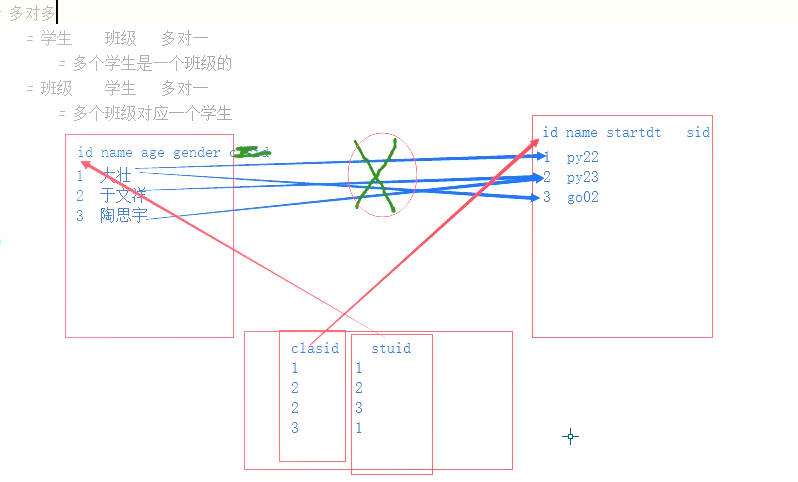一、存储引擎
存储数据的方式。
一张表:①数据;②表的结构;③索引(查询的时候使用的一个目录结构)
1、Innodb存储引擎——mysql5.6之后默认的存储引擎
① 数据和索引存储在一起(2个文件)
数据索引、表结构
② 数据持久化
③ 支持事务:未来保证数据的完整性,将多个操作变成原子性操作。
④ 支持行级锁:修改的行少的时候使用
⑤ 支持表级锁:批量修改多行的时候使用
⑥ 支持外键:约束两张表中的关联字段不能随意的添加\删除
2、Myisam存储引擎——mysql5.5之前的默认存储引擎
① 数据和索引不存储在一起(3个文件)
数据、索引、表结构
② 只支持表级锁
3、Memory存储引擎
① 数据存储在内存中,也就是说数据断电消失(1个文件)
表结构

4、面试问题
(1)你了解mysql的存储引擎吗?
(2)你的项目中用来什么引擎,为什么?
用的Innodb存储引擎,原因有:
① 多个用户操作的过程中对同一张表的数据同时修改;
② Innodb支持行级锁,所以我们使用了这个存储引擎;
③ 为了适应程序未来的扩展性,扩展新功能的时候可能会用到。。。涉及到要维护数据的完整性;
④ 项目中有一两张xx xx表,之间的外键关系是什么,一张表的修改或者删除比较频繁,怕出错所以做了外键约束。
二、存储引擎测试
1、查看引擎
mysql> show variables like '%engine%';
2、在建表时指定引擎
mysql> create table ai(id bigint(12), name varchar(200)) ENGINE=InnoDB;
【tips】查看所建的表的详细信息:mysql> show create table engin1;
(1)创建的默认表(InnoDB存储引擎)
(2)创建Myisam存储引擎的表

三、表和数据的基础操作
1、创建表
create table 表名( id int, name char(18), 字段名3 类型[(宽度) 约束条件] ); # 放在中括号里的内容可以不写
2、写入数据的方式(3种)
insert into 表 values (值1,值2,值3); # 这张表有多少的字段,就需要按照字段的顺序写入多少个值 insert into 表 values (值1,值2,值3),(值1,值2,值3),(值1,值2,值3); # 一次性写入多条数据 insert into 表 (字段1,字段3 ) values (值1,值3); # 指定字段名写入,可以任意的选择表中你需要写入的字段进行
3、查看表中的数据
select * from 表
4、查看表结构
desc 表名; # 能够查看到有多少个字段\类型\长度,看不到表编码,引擎,具体的约束信息只能看到一部分 show create table 表名; # 能查看字段\类型\长度\编码\引擎\约束
5、删除表
drop table 表名
四、MySQL中的数据类型
1、数字
# int 不约束长度,最多表示10位数 float(m,n) m 一共多少位, n 小数部分多少位 create table t1( id int, # 默认是有符号的 age tinyint unsigned # 如果需要定义无符号的使用unsigned ); create table t2( f1 float(5,2), # 保留2位小数 并四舍五入 f2 float, f3 double(5,2), f4 double ); insert into t2(f2,f4) values(5.1783682169875975,5.1783682169875975179); create table t3( f1 float, # 保留2位小数 并四舍五入 d1 double, d2 decimal(30,20), d3 decimal ); insert into t3 values(5.1783682169875975179,5.1783682169875975179, 5.1783682169875975179,5.1783682169875975179);
2、字符串
主要是char和varchar两种。
(1)char和varchar的介绍和区别
① char(18) 最多只能表示255个字符 定长存储,浪费空间,节省时间 'alex' 'alex ' ② varchar(18) 最多能表示65535个字符 变长存储,节省空间,存取速度慢 'alex' 'alex4' 适合使用char 身份证号 手机号码 qq号 username 12-18 password 32 银行卡号 适合使用varchar 评论 朋友圈 微博
(2)操作格式
create table t6(c1 char(1),v1 varchar(1),c2 char(8),v2 varchar(8));
create table t6(c1 char,v1 varchar(1),c2 char(8),v2 varchar(8));
3、时间
(1)常用的时间
date 20190620 time 121953 datetime 20190620121900
(2)格式
mysql>create table t4( dt datetime, y year, d date, t time, ts timestamp );
# 让datetime也可以向timestamp那样,自动实现插入当前时间 mysql> create table t5( -> id int, -> dt datetime NOT NULL # 不能为空 DEFAULT CURRENT_TIMESTAMP # 默认是当前时间 ON UPDATE CURRENT_TIMESTAMP);
4、enum/set
enum 单选行为
set 多选行为
# enum create table t8( id int, name char(18), gender enum('male','female') ); # set create table t9( id int, name char(18), hobby set('抽烟','喝酒','烫头','洗脚') );
五、完整性约束
1、无符号的 int unsigned
# 无符号的 create table t10( id int unsigned );
2、不能为空 not null
(1)严格模式设置:在my.ini里输入下面的内容(永久的话)
# not null的严格设置:(要是不为空的情况下不输入有效,则需要开启) #(1)直接在myasql中生效(重启失效) mysql> sqi_mode="STRICT_TRANS_TABLES,NO_AUTO_CREATE_USER,NO_ENGINE_SUBSTITUTION"; #(2)配置文件添加(永久有效) sqi_mode="STRICT_TRANS_TABLES,NO_AUTO_CREATE_USER,NO_ENGINE_SUBSTITUTION"
(2)操作格式
create table t11( id int unsigned not null, name char(18) not null );
3、默认值
# 设置默认是,假如你不输入,那么会自动输入默认值 create table t12( id int unsigned not null, name char(18) not null, sex enum('male','female') not null default 'male' );
4、不能重复 unique
# 不能重复 (值不能重复,但是null可以) create table t13( id1 int unique, id2 int );
联合唯一:IP+端口
create table t14( id int, server_name char(12), ip char(15), port char(5), unique(ip,port) );
5、自增
只对数字有效,自带非空约束;
至少是unique的约束之后才能使用。
# 自增 create table t16( id int primary key auto_increment, # id会自动增加 name char(12) );
6、主键
(1)第一个被定义为非空+唯一时那一列会成为这张表的primary key
可以指定主键(primary key)
(2)联合主键
# 联合主键 create table t15( id int, server_name char(12), ip char(15), port char(5), primary key(ip,port) );
7、外键
# 外键 # 将学生表和班级表关联在一起(先建班级表,后建学生表) # 班级表 create table my_class( cid int primary key auto_increment, cname char(12) not null, startd date ); # 学生表 create table stu( id int primary key auto_increment, name char(12) not null, gender enum('male','female') default 'male', class_id int, foreign key(class_id) references my_class(cid) );
级联更新级联删除:可以在关联下删除和修改。(权限比上面的高)——不建议用,危险
# 班级表 create table my_class( cid int primary key auto_increment, cname char(12) not null, startd date ); # 学生表 create table stu( id int primary key auto_increment, name char(12) not null, gender enum('male','female') default 'male', class_id int, foreign key(class_id) references my_class(cid) on update cascade on delete cascade );
【注】cascade 可以换成 set null(删除后,设置为null)、No action(不能进行删除和更新)、Restrict(不能进行删除和更新)、Set default
六、修改表
1、修改表名
alter table 表名 rename 新表名;
2、增加字段
alter table 表名 add 字段名 数据类型 [完整性约束];
3、删除字段
alter table 表名 drop 字段名;
4、修改字段
alter table 表名 modify 字段名 数据类型 [完整性约束];
alter table 表名 change 旧字段名 新字段名 旧数据类型 [完整性约束];
alter table 表明 change 旧字段名 新字段名 新数据类型 [完整性约束];
5、修改字段排列顺序/在增加的时候指定字段位置
alter table 表名 add 字段名 数据类型 [完整性约束] first;
alter table 表名 add 字段名 数据类型 [完整性约束] after 字段名;
alter table 表名 change 字段名 旧字段名 新字段名 数据类型 [完整性约束] first;
alter table 表名 modify 字段名 数据类型 [完整性约束] after 字段名;
6、添加和去掉null与unique约束
添加:alter table t modify name char(10) null;
去掉:alter table t modify name char(10) not null;
添加:alter table t modify id int unique;
去掉:alter table t drop index id;
七、多表结构的创建与分析
1、多对一
# 多对一 # 学生 班级 # 多个学生是一个班级的 # 学生表有一个外键 关联班级表 # 书籍 作者 # 多本书可以都是一个作者写的 # 书籍表有一个外键 关联作者表 # 书籍 出版社 # 多本书可以是一个出版社出版的 # 书籍表有一个外键 观看出版社表 # 商品 订单 # 多个商品可以在一个订单里 # 商品表有一个外键 订单表

create table press( id int primary key auto_increment, name varchar(20) ); create table book( id int primary key auto_increment, name varchar(20), press_id int not null, foreign key(press_id) references press(id) on delete cascade on update cascade ); insert into press(name) values ('北京工业出版社'), ('人民出版社'), ('知识产权出版社') ; insert into book(name,press_id) values ('九阳神功',1), ('九阴真经',2), ('九阴白骨爪',2), ('独孤九剑',3), ('降龙十巴掌',2), ('葵花宝典',3) ;

2、多对多
# 多对多——出现第三张表(两个外键) # 学生 班级 多对一 # 多个学生是一个班级的 # 班级 学生 多对一 # 多个班级对应一个学生 # 一本书可以有多个作者 # 一个作者可以写多本书 # 一个商品可以有多个订单 # 一个商品可以有多个订单


create table author( id int primary key auto_increment, name varchar(20) ); #这张表就存放作者表与书表的关系,即查询二者的关系查这表就可以了 create table author2book( id int not null unique auto_increment, author_id int not null, book_id int not null, constraint fk_author foreign key(author_id) references author(id) on delete cascade on update cascade, constraint fk_book foreign key(book_id) references book(id) on delete cascade on update cascade, primary key(author_id,book_id) ); #插入四个作者,id依次排开 insert into author(name) values('egon'),('alex'),('yuanhao'),('wpq'); #每个作者与自己的代表作如下 egon: 九阳神功 九阴真经 九阴白骨爪 独孤九剑 降龙十巴掌 葵花宝典 alex: 九阳神功 葵花宝典 yuanhao: 独孤九剑 降龙十巴掌 葵花宝典 wpq: 九阳神功 insert into author2book(author_id,book_id) values (1,1), (1,2), (1,3), (1,4), (1,5), (1,6), (2,1), (2,6), (3,4), (3,5), (3,6), (4,1);
3、一对一
# 一对一 # 客服 —— 学生 # unique foreign key unique

create table customer( id int primary key auto_increment, name varchar(20) not null, qq varchar(10) not null, phone char(16) not null ); create table student( id int primary key auto_increment, class_name varchar(20) not null, customer_id int unique, #该字段一定要是唯一的 foreign key(customer_id) references customer(id) #外键的字段一定要保证unique on delete cascade on update cascade ); #增加客户 insert into customer(name,qq,phone) values ('韩蕾','31811231',13811341220), ('杨澜','123123123',15213146809), ('翁惠天','283818181',1867141331), ('杨宗河','283818181',1851143312), ('袁承明','888818181',1861243314), ('袁清','112312312',18811431230); #增加学生 insert into student(class_name,customer_id) values ('脱产1班',3), ('周末1期',4), ('周末1期',5);
【注】本次学习并借鉴的地址:https://www.cnblogs.com/Eva-J/articles/9677452.html#_labelTop
